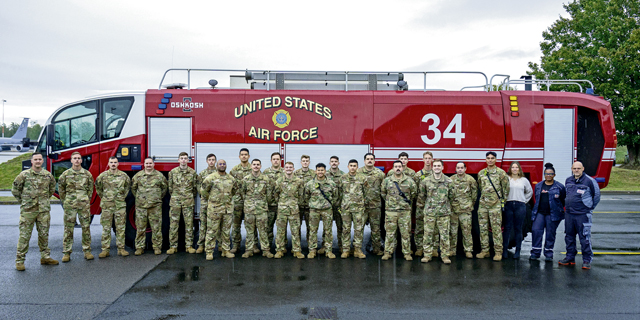
Petroleum-oil-lubricant based fuel fires pose a high hazard and present a particular challenge for firefighters. POL fires are difficult to extinguish with water as POL is lighter than water and tends to float on top. In the past, aqueous film forming foam was injected into the water stream to smother POL vapors and extinguish the fire. The AFFF and water mixture created a thin film layer over the POL product and created bubbles which trapped fuel vapors allowing the fire to be deprived of oxygen and then become extinguished.
In the past, long chain per- and polyfluorinated alkyl acids were the main ingredient used to manufacture MilSpec C8 AFFF used for combating POL fires. Although AFFF firefighting properties were excellent, they contained PFAS which are now known as ‘forever chemicals,’ hazardous to the environment and health. PFAS can also found in many consumer products with water-proofing or non-stick properties.
In 2016, Ramstein Air Base switched to an alternative AFFF and filled their fire trucks with a C6 AFFF containing a short-chain PFAS element. The properties and firefighting capabilities remained high and proved valuable in extinguishing POL products.
Following years of research, the findings indicate C6 AFFF still contained elements harmful to life, health and the environment. The Department of Defense was tasked by Congress to develop a fluorine free foam and permanently eliminate AFFF from its installations by Sep. 30.
The 86th Civil Engineer Squadron led the charge to dispose of over ten tons of AFFF through its Fire and Emergency Services Flight and Environmental Specialists. The biggest challenge during the firefighting foam swap to a new fluorine free foam was maintaining emergency response capabilities for the airfield during the transition process. The F&ES flight was tasked to empty the AFFF foam tanks, rinse each tank, then allow the tanks to fully air dry before filling the tanks with the new F3.
An additional limitation to their work was the physical location of all the apparatus as they are spread out over three geographically separated bases comprised of seven fire stations which protect the Kaiserslautern Military Community. This distance, coupled with the need to remain fully operational to safeguard the KMC presented a logistical challenge, but the team completed the transfer without reducing a level of service to our community or mission partners.
AFFF was not only used in fire trucks, but also in aircraft hangars. Hangar fire protection systems were problematic as the systems were prone to unintentional activation associated with electronic component failure or human error. To correct this issue, a two-fold resolution was put in place.
The first action was to lock-out, tag-out the system which disabled foam tanks and piping going into the hangar’s installed fire protection system. Piping was removed to ensure accidental activation was not possible. The second and final phase was to remove all AFFF, approximately 10,906 gallons, from the foam tanks dedicated to the hangar fire suppression systems. These tanks will be emptied and rinsed with a target completion date by the end of October.
PFAS avoidance is the most prudent measure when dealing with the substance. To further protect the health of residents and personnel on the installation, the installation-owned drinking water treatment plants efficiently filter out PFAS using multi-layer carbon filters. Drinking water is sampled and analyzed continuously to verify it meets standards.
Team Ramstein would like to thank the 86th Civil Engineer Squadron, especially its firefighters and environmental specialists, as well as Südmüll GmbH and Tetratech GmbH for its cooperation and outstanding interdisciplinary partnership supporting Defense Department-wide efforts to remove PFAS from firefighting operations to safeguard our community and our installation.


